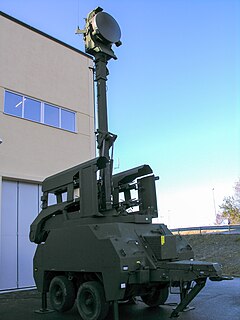
ASRAD-R (Advanced Short Range Air Defence System - RBS) is a vehicle-mounted short-range air defense system, designed by a joint German-Swedish effort between Rheinmetall and Saab Bofors Dynamics. The system is modular and can be mounted on almost any wheeled or tracked vehicle. It has for instance been demonstrated mounted on an M113 armoured personnel carrier.
Rheinmetall AG is a European defence contractor. Rheinmetall has a presence in two corporate sectors with six divisions, and is headquartered in Düsseldorf, Germany. In fiscal 2018, the company generated sales of €6.148 billion.
Saab Bofors Dynamics, located in Karlskoga and Linköping, Sweden, is a subsidiary of the Saab Group that specializes in military materiel such as missile systems and anti-tank systems.

The M113 is a fully tracked armored personnel carrier (APC) that was developed and produced by the Food Machinery Corp (FMC). The M113 was sent to USAREUR to replace the mechanized infantry's M59 APCs in the 1961/62 time frame. The M113 was first tried out in combat in April 1962 after the United States provided the South Vietnamese Army (ARVN) with heavy weaponry such as the M113, under the Military Assistance Command, Vietnam (MACV) program. Eventually, the M113 was the most widely used armored vehicle of the U.S. Army in the Vietnam War, earning the nickname 'Green Dragon' by the Viet Cong as it was used to break through heavy thickets in the midst of the jungle to attack and overrun enemy positions. It was largely known as an "APC" or an "ACAV" by the allied forces.
Contents
Normally the same vehicle carries both the main sensor and the main effector of the system. However, thanks to the systems modularity, it can also be delivered in a split configuration with one vehicle carrying the main sensor and several other vehicles carrying the missiles.
The main sensor is Saab's (formerly Ericsson Microwave System) HARD AESA air search 3D radar with an instrumented range of 20 km or an Infra-red search and track, depending upon the customer's specifications. The effector is the latest version of the Saab Bofors Dynamics RBS 70 surface-to-air missile, called Bolide. The missile is a laser guidance beam riding short range missile equipped with a highly effective proximity fuze. It is supposed to be effective against cruise missiles.

An active electronically scanned array (AESA) is a type of phased array antenna, which is a computer-controlled array antenna in which the beam of radio waves can be electronically steered to point in different directions without moving the antenna. In the AESA, each antenna element is connected to a small solid-state transmit/receive module (TRM) under the control of a computer, which performs the functions of a transmitter and/or receiver for the antenna. This contrasts with a passive electronically scanned array (PESA), in which all the antenna elements are connected to a single transmitter and/or receiver through phase shifters under the control of the computer. AESA's main use is in radar, and these are known as active phased array radar (APAR).

3D radar provides for radar coverage in three dimensions; unlike the more common 2D radar which provides range and bearing, the 3D radar also provides elevation. Applications include weather monitoring, air defense, and surveillance.

RBS 70 is a man-portable air-defense system (MANPADS) designed for anti-aircraft warfare in all climate zones and with little to no support from other forces. Originally designed and manufactured by the Swedish defence firm of Bofors Defence. It uses the RB 70 missile which is also in use in a number of other Swedish missile systems.
Each unit is equipped with four ready-to-fire missiles and an optical day and night sight to continually point the laser beam at the target. This means the system makes use of ACLOS type of guidance. Since the laser receiver is located at the back of the missile the system is practically immune to jamming but the method can be hampered by very low-visibility atmospheric conditions.
Finland placed the first order in August 2002. The Finnish systems are mounted on Sisu Nasus (four units) and Mercedes-Benz Unimog 5000 L/38 4x4s (12 units). Each battery also has four RBS 70 MANPADS launchers with Bolide missiles.

The Nasu is a tracked articulated, all-terrain transport vehicle developed by Sisu Auto for the Finnish Army. It consists of two units, with all four tracks powered. It can carry up to 17 people, although the trailer unit can be adapted for different applications. There are two main versions, the NA-140 BT and the NA-110.















